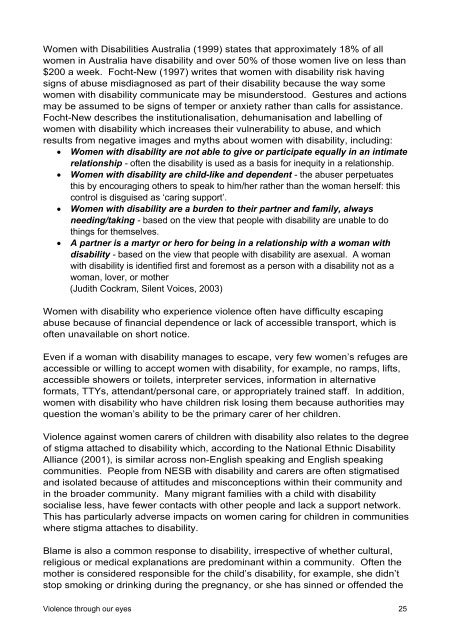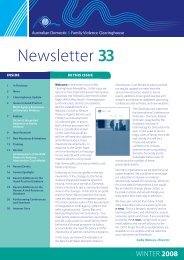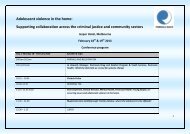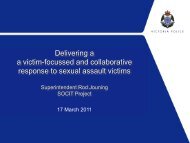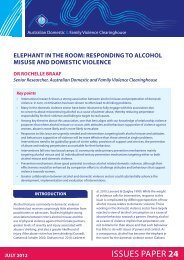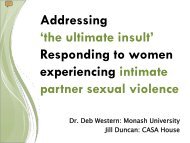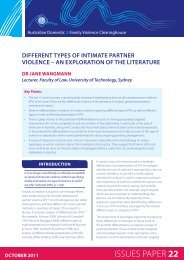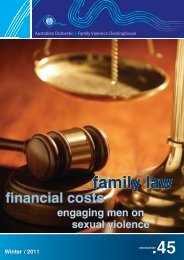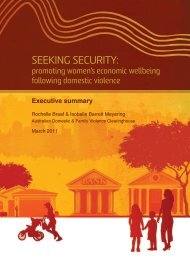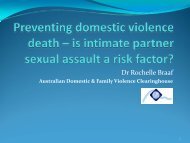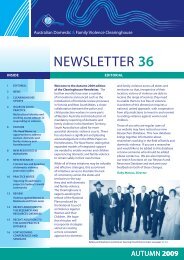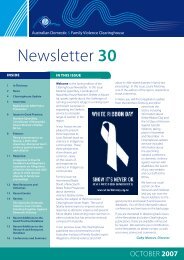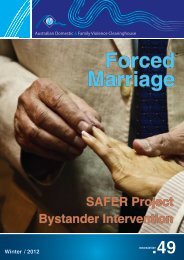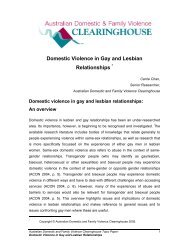Violence through our eyes - Women With Disabilities Australia
Violence through our eyes - Women With Disabilities Australia
Violence through our eyes - Women With Disabilities Australia
Create successful ePaper yourself
Turn your PDF publications into a flip-book with our unique Google optimized e-Paper software.
<strong>Women</strong> with <strong>Disabilities</strong> <strong>Australia</strong> (1999) states that approximately 18% of all<br />
women in <strong>Australia</strong> have disability and over 50% of those women live on less than<br />
$200 a week. Focht-New (1997) writes that women with disability risk having<br />
signs of abuse misdiagnosed as part of their disability because the way some<br />
women with disability communicate may be misunderstood. Gestures and actions<br />
may be assumed to be signs of temper or anxiety rather than calls for assistance.<br />
Focht-New describes the institutionalisation, dehumanisation and labelling of<br />
women with disability which increases their vulnerability to abuse, and which<br />
results from negative images and myths about women with disability, including:<br />
• <strong>Women</strong> with disability are not able to give or participate equally in an intimate<br />
relationship - often the disability is used as a basis for inequity in a relationship.<br />
• <strong>Women</strong> with disability are child-like and dependent - the abuser perpetuates<br />
this by enc<strong>our</strong>aging others to speak to him/her rather than the woman herself: this<br />
control is disguised as ‘caring support’.<br />
• <strong>Women</strong> with disability are a burden to their partner and family, always<br />
needing/taking - based on the view that people with disability are unable to do<br />
things for themselves.<br />
• A partner is a martyr or hero for being in a relationship with a woman with<br />
disability - based on the view that people with disability are asexual. A woman<br />
with disability is identified first and foremost as a person with a disability not as a<br />
woman, lover, or mother<br />
(Judith Cockram, Silent Voices, 2003)<br />
<strong>Women</strong> with disability who experience violence often have difficulty escaping<br />
abuse because of financial dependence or lack of accessible transport, which is<br />
often unavailable on short notice.<br />
Even if a woman with disability manages to escape, very few women’s refuges are<br />
accessible or willing to accept women with disability, for example, no ramps, lifts,<br />
accessible showers or toilets, interpreter services, information in alternative<br />
formats, TTYs, attendant/personal care, or appropriately trained staff. In addition,<br />
women with disability who have children risk losing them because authorities may<br />
question the woman’s ability to be the primary carer of her children.<br />
<strong>Violence</strong> against women carers of children with disability also relates to the degree<br />
of stigma attached to disability which, according to the National Ethnic Disability<br />
Alliance (2001), is similar across non-English speaking and English speaking<br />
communities. People from NESB with disability and carers are often stigmatised<br />
and isolated because of attitudes and misconceptions within their community and<br />
in the broader community. Many migrant families with a child with disability<br />
socialise less, have fewer contacts with other people and lack a support network.<br />
This has particularly adverse impacts on women caring for children in communities<br />
where stigma attaches to disability.<br />
Blame is also a common response to disability, irrespective of whether cultural,<br />
religious or medical explanations are predominant within a community. Often the<br />
mother is considered responsible for the child’s disability, for example, she didn’t<br />
stop smoking or drinking during the pregnancy, or she has sinned or offended the<br />
<strong>Violence</strong> <strong>through</strong> <strong>our</strong> <strong>eyes</strong> 25


